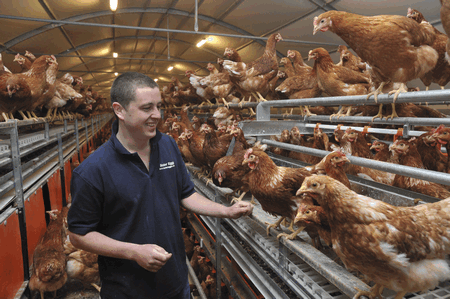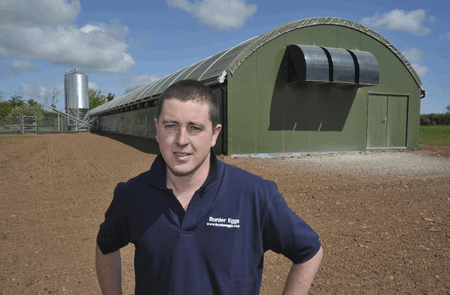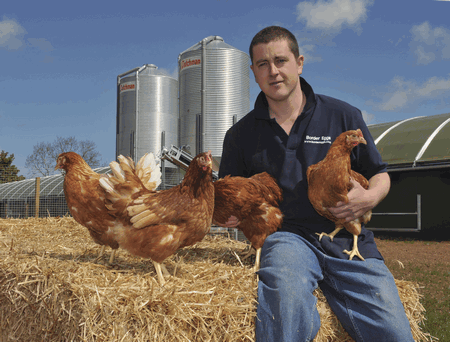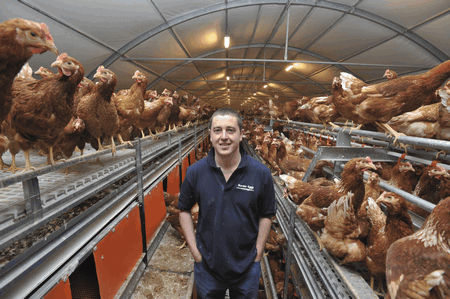Organic egg producer chooses muilti-tier system

James Maclean was just 29 when he decided to set up an organic egg farm near Berwick on Tweed, just over a year ago. He first opted for a mobile system, based on land he rents from his father, capable of holding 3000 birds.
Being mobile, at the end of a flock, he could easily clean it and move it onto fresh ground before being restocked. It was, therefore, ideally suited for Mr Maclean’s first flock.
And after the success of his first flock and having seen a good return, Mr Maclean decided to triple the size of the poultry unit by adding a second shed.
However, due to his expansion plans, he opted for a multi-tier static shed instead of another mobile unit. He was attracted by its ability to house twice the number of birds. Both sheds were supplied by Newquip.
Its compact design means it can hold 6000 birds in total without the need of increasing the building size.

The dimensions of the shed are 91.4 m (300ft) long by 9.1m (30ft) wide, and as it’s a multi-tier shed, it also provides more space inside allowing for two tiers in total.
Although it has meant more of a financial investment for Mr Maclean, the benefits of the static shed are that it offers some unique features. One of them is a motorised belt which removes dung from the shed.
At the touch of a switch, the belt begins to move, quickly pulling the dung from the birds out of the shed. It is then loaded with ease onto a trailer and removed from the site.
Not only does this save time but it also means a reduction in flies, odour and above all it provides a better environment for the birds. “It should also allow a quicker turnaround as we will not have to move the shed and the dung is already removed weekly,” he says.
The shed also comes with a large scratch area and every second section has a pop hole. Where six pop holes are usually required, there are eight in total, says Mr Maclean.

Both sheds are powered ventilation and have solid sides rather than standard curtain sided mobile. The reason behind this is for better light control as the curtains are still able to let daylight in, he says.
Solid sides to the building prevent wind chill during cold spells. And with computer controlled heating system and gable end fans, a constant temperature can be maintained, even on a hot day.
The floor of the shed is made of 25mm (0.98in) that is supported on a metal frame. “It’s the right building for my situation, I rent the ground and I didn’t want a concrete based building.
“When the sheds come to the end of their lives, they can be stripped down easily and won’t affect the good arable land they are built on. The multi-tier arrangement works in my situation,” says Mr Maclean.
Since the completion of the static building and the arrival of the new flock, Mr Maclean says that the birds are currently performing well and gaining sufficient weight.
He has since employed a full-time worker to help manage the new multi-tier system alongside the mobile shed unit.

And the static shed is living up to his expectations so far. Initially getting the birds to roost on the system at night was a problem but this has been gradually overcome in a weeks worth of training, he adds.
“The benefits so far are that there are a lot more places for the birds to go which means they can jump around a lot and consequently are less bored.
“It is a little more dusty than the first mobile shed because the birds are jumping and flying about a lot more but its not a major issue,” he says.
“The layout also means it’s easy for me to walk the system to inspect the birds and floor eggs are much easier to spot,” he adds. “A wire runs along the lower edge of the sloped slats to catch any floor eggs, making them easier to see and collect from the ground.”

Forward thinking made Mr Maclean choose sheds suitable for free-range flocks which means he can alter the set up from organic to standard free-range with ease if the need arises.
“I decided to start with organic but if something happens with disease or the there is a change in the market, I can easily switch to free-range if I need to,” he adds.
But as the requirements for free-range is 9 birds/sq m and organic regulations require 6 birds/sq m, Mr Maclean’s flock currently have the added advantage of more space to roam freely around in.
He currently has 3000 birds in the mobile unit and 6000 birds in the static unit but the static can hold 8640 in total, if he decided to change systems and produce to free-range eggs.
The extra space also means less competition between the birds to get to the feeders and drinkers.
For the present time however, Mr Maclean is focusing on organic eggs and having already established a contract with Noble eggs, he believes there is a niche in the market within his area. “The packers manage the market well, they won’t let the market become flooded,” he says.
Mr Maclean also sells eggs locally from his company Border Eggs which are delivered quickly after they are sold. “We box them ourselves and deliver them within two days so our customers get them when they are as fresh as possible.”
The flexibility with managing the organic system means he is able to also manage the arable side of the business along side the egg unit.
The reason I went into organic is because of the returns it offers and the hours it takes to manage, it would take more time to look after a free-range egg system of a sufficient size to give the same return as the organic at present and this way it marries well with the arable side of the business, he adds.
Mr Maclean says while it has been a challenge and a learning curve with two new sheds, if all goes well he would consider expanding to another multi-tier shed.
- At 20 weeks, just starting to lay
- Static shed production figures
- % egg production:25%
- Egg weight: 50gms
- Bird weight: 1850gms
For more information on multi-tier and mobile units contact Newquip.
